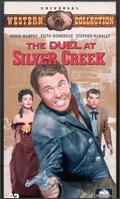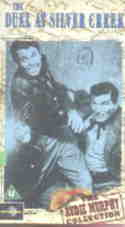
|

|

|
|---|

|

|

|
|---|
 Foto: Audie Murphy und Susan Cabot |
||
| "Lightning, der Sheriff von Silver City, will den
Mord an seinem besten Freund rächen. Das Mädchen Opal lenkt ihn
von dieser Aufgabe ab, denn der Mörder ist ihr Bruder. Einer, der sich
durch nichts ablenken läßt, ist Lightnings Stellvertreter, Kid."
(Hembus: Western-Lexikon) |
||
 Der Film ist die Geschichte einer über kriminelle wie romantische Bande spielenden Gruppe von zwei Männern und zwei Frauen. Der Sheriff Lightning Tyrone ist doppelt gehandicapt: einst der schnellste Schütze weit und breit, zieht er nach einer Schußverletzung zwar so schnell wie eh und je, kann aber nicht mehr abdrücken. Dieser Form von Impotenz korrespondiert eine ziemlich komplette Liebesblindheit. Dusty, die Frau, die ihn liebt, nimmt er nicht wahr, nur um auf die billigsten Tricks der Frau hereinzufallen, die ihn für ihre verbrecherischen Aktionen ausnützt. Silver Kid ist die Gegenfigur: er liebt die Frau, die den Sheriff unglücklich liebt und er durchschaut Opal, die Lightning den sonst klaren Kopf verdreht hat. In erfolgreicher Doppelaktion gelingt es ihm, die Liebe Dustys zu gewinnen und die Machenschaften der Verbrecherbande zu durchschauen. Interessanterweise ist Lightning Tyrone der voice-over Ich-Erzähler des Films, der stoisch über seine eigene Torheit hinwegerzählt - allerdings wird die Perspektive, wie das im klassischen Hollywoodfilm üblich ist, immer wieder objektiv geweitet. Die Geschichte hat bei genauerer Betrachtung logische, erzählerische und psychologische Löcher en masse. Durch das hohe Erzähltempo und die Weigerung, sich auf die Figuren genauer einzulassen, fällt das aber nicht weiter störend auf. Die Dialoge lassen Ansätze zu Screwball-Absichten erkennen, zu sich selbst aber findet der Film in der periodisch eingestreuten wilden Jagd zu Pferde: die rasante Kamera (in Verbindung mit der aufbrausenden, heftig orchestrierten Musik) fährt die Narration in Grund und Boden - und manche Schwenks sowie das Spiel der Einstellungen beim abschließenden Showdown sind sehr elegant. Der nachträglich angefügte Prolog ist an sich recht gelungen, freilich fällt die totale Bezuglosigkeit der späteren Plot-(nicht Story-)Geschehnisse auf das dort Gezeigte doch auf. |
|
|
| James Anderson
Susan Cabot Faith Domergue (Foto) George Eldredge Eugene Iglesias Kyle James Lee Marvin Stephen McNally (Foto) Gerald Mohr Audie Murphy (Foto) Walter Sande |
- Bit - Dusty Fargo - Opal Lacey - Jim Ryan - Johnny Sombrero - Rat Face Blake - Tinhorn Burgess - Lightning Tyrone - Rod Lacey - Silver Kid - Pete Fargo |
Don Siegel Leonard Goldstein Gerald Drayson Adams Joseph Hoffman Irving Glassberg Hans Salter Herman Stein Russell Schoengarth Alexander Golitzen Bernard Herzbrun Joseph E. Gershenson Russell A. Gausman Joe Kish Joseph Kish Bill Thomas Bud Westmore Leslie I. Carey Corson Jowett |
- Regie
- Produzent - Drehbuch - Drehbuch - Kamera - Musik/Komponist - Musik/Komponist - Schnitt - Art Director - Art Director - Musikalische Leitung - Set Decoration/Design - Set Decoration/Design - Set Decoration/Design - Kostüme - Makeup - Sound/Sound Designer - Sound/Sound Design |
|
|
 "I remember going to see Goldstein who was the producer to ask permission to finish the script so that at least I would know who gets the girl. I didn't think that was too awful a request for a director to make. He said: 'Kid, how many pictures have I made this year?' It was then November - I said: 'Gosh, I don't know I believe you've made an awful lot.' He said: 'I've made 19 and I didn't make them by pushing them back two weeks.' So I went into the picture not knowing whether Steve McNally or Audie Murphy got the girl. I couldn't take the picture  seriously. The script was short. To make it look longer
we left a lot of space between each shot description in the final big gun
battle. It gave us a good page count, and the studio
told us to go ahead and start shooting. i started to get compliments on the
dailies from the executives and told them I was afraid we might be running
short, but they said: 'Keep up the same pace, don't change anything.' I wound
up with a 54-minute movie and had to dream up a prologue about Audie Murphy
and his father to expand it to 77 minutes." seriously. The script was short. To make it look longer
we left a lot of space between each shot description in the final big gun
battle. It gave us a good page count, and the studio
told us to go ahead and start shooting. i started to get compliments on the
dailies from the executives and told them I was afraid we might be running
short, but they said: 'Keep up the same pace, don't change anything.' I wound
up with a 54-minute movie and had to dream up a prologue about Audie Murphy
and his father to expand it to 77 minutes."
(Lovell Interviews, S. 52/3) --------------------------------------------------------------------------------------- Ich erinnere mich, daß ich zu Goldstein ging, das war der Produzent, und ihn um Erlaubnis fragte, das Drehbuch fertigzuschreiben, so daß wenigstens ich wüßte, wer das Mädchen kriegt. Das schien mir für den Regisseur keine völlig maßlose Forderung. Er sagt: 'Hast du eine Ahnung, mein Junge, wie viele Film ich dieses Jahr gemacht habe?' Es war November - ich sagte: 'Ehrlich, keine Ahnung, eine ganze  Menge, schätze ich.'
Er sagte: '19 Stück, und bestimmt nicht dadurch, daß
ich die Dreharbeiten zwei Wochen nach hinten verschoben habe.'
So habe ich also mit dem Film angefangen, ohne zu wissen, ob Steve McNally
oder Audie Murphy das Mädchen kriegen würde. Ich
konnte den Film nicht ernst nehmen. Das Drehbuch war sehr kurz. Damit
es länger aussah, ließen wir eine
Menge Platz zwischen der Beschreibung jeder Einstellung in
der großen Gewehrschlacht am Ende. Von der Seitenzahl sah
das ordentlich aus und das Studio sagte, wir sollten endlich anfangen.
Die Produzenten lobten die täglichen Aufnahmen bei
der Vorführung, aber ich sagten ihnen, der Film
könnte zu kurz werden. Sie meinten nur: 'Das Tempo
beibehalten, nichts ändern.' Am Ende stand ich mit 54 Minuten
da und mußte mir einen Prolog über Audie Murphy und seinen Vater
aus den Fingern saugen, um auf 77 Minuten zu kommen.
------------------------------------------------------------------------------------------ Menge, schätze ich.'
Er sagte: '19 Stück, und bestimmt nicht dadurch, daß
ich die Dreharbeiten zwei Wochen nach hinten verschoben habe.'
So habe ich also mit dem Film angefangen, ohne zu wissen, ob Steve McNally
oder Audie Murphy das Mädchen kriegen würde. Ich
konnte den Film nicht ernst nehmen. Das Drehbuch war sehr kurz. Damit
es länger aussah, ließen wir eine
Menge Platz zwischen der Beschreibung jeder Einstellung in
der großen Gewehrschlacht am Ende. Von der Seitenzahl sah
das ordentlich aus und das Studio sagte, wir sollten endlich anfangen.
Die Produzenten lobten die täglichen Aufnahmen bei
der Vorführung, aber ich sagten ihnen, der Film
könnte zu kurz werden. Sie meinten nur: 'Das Tempo
beibehalten, nichts ändern.' Am Ende stand ich mit 54 Minuten
da und mußte mir einen Prolog über Audie Murphy und seinen Vater
aus den Fingern saugen, um auf 77 Minuten zu kommen.
------------------------------------------------------------------------------------------ |
| Duel at Silver
Creek was interesting. There was no duel and no creek. Also, the names of
the characters in the picture were unbelievably amusing.
Siegel Film 137 -------------------------------------------------------------------------------------------- Duel at Silver Creek war interessant. Es gab kein Duell und keinen Bach (creek). Auch die Namen der Charaktere waren außerordentlich amüsant. -------------------------------------------------------------------------------------------- |
| "There were a number of other films I enjoyed making
and some of them were westerns like Santa Fe Passage, Duel at Silver Creek,
and Escort West (1959). Duel at Silver Creek was a fun film. The man who
produced it was Leonard Goldstein, and Leonard had been producing a lot of
the films my husband (Hugo Fregonese, E.K.) was directing, and I thought
I had the most beautiful clothes since Gone With the Wind in this film. I
had exquisite 1880s' style clothes. The director, Don Siegel, was a great
director and a man with a lot of patience.
"We shot the Great Sioux Uprising in Pendleton, Oregon, and my fondest memory of this film is that they used fishermen from the Umatilla Indian Tribe. They never rode horses. They fished, and here they had them playing Sioux Indians who were the greatest horsemen of all! When we would have a run-through for the camera, we had more Indians hurt because they were flying off the horses and were scattered around the field. They were excited about doing it and wanted to work, but did have their proble ms riding horseback.(...) I've had some dreadful experiences and in Duel at Silver Creek, I did a lot of riding in this one, and we were shooting out at Vasquez Rocks (outside of Los Angeles) and had a posse following us. My horse slipped at full gallop, and if I had fallen off the horse with a posse roaring up behind me, I'd have been killed. When the insurance company finally found out that I was riding, they took me off the horse. Aus einem Interview mit Faith Domergue |
"A low budget
Western and an example of a film being impossibly handicapped by its production
situation. The plot is at once very simple and very complicated; there had
been no time before the start of shooting to sort it out. The maintenance
of a fast narrative pace throughout the picture cannot disguise its inadequacies.
|
|
| ---allmovie---imdb---lexikon des internationalen films--- |

![]()